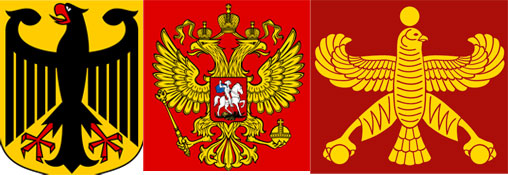In my previous post I touched on the idea that clues to our future can be gleaned from events in the past. The idea is that past events have a kind of prophetic echo in future events, especially where past events hold high symbolic value in the collective psyche of people. Ancient Babylon is one such historical entity, a system of government saturated in potent symbolism that has a direct bearing on one of today’s most important institutions – the very troubled and fraudulent international finance system of central banking.
The fall of ancient Babylon is packed full with clues about the nature of the impending implosion of the international finance system.
Readers of the Saturn Death Cult parts 1 and 2 will be aware of a central tenet linking ancient Babylon with the modern finance system as it is run by today’s central bankster institutions. The modern manifestation of ancient Babylon is symbolically referred to as Mystery Babylon, or occult Babylon. It is a kingdom of merchants (banksters) operating a system of finance that enslaves whole nations through the issuance of debt-based money. This system has for millennia been vilified by the world’s major religions as usury.
The world’s central banks are the financial wing of the Saturn Death Cult
The fall of ancient Babylon is recorded in the 5th chapter of the biblical book of Daniel. Babylon falls to the Medes and Persians when they cleverly dried up the Euphrates river to allow the Persian soldiers access to Babylon under its massive walls. The king of Babylon was, at the time, slumbering in a drunken stupor, oblivious to the threat. In my previous post I alluded to Wall Street’s drunken orgy in dealing out fraudulent financial products and the subsequent drying up of financial liquidity as symbolic echoes of ancient Babylon’s fall.
However, we are only halfway through events as they stand in today’s financial crisis and we have yet to see the prophetic echo of triumphant Persian troops entering into the international finance system courtesy of a dried-up river of financial liquidity. If this scenario holds any water (pun?) as a forecasting tool for future events in the ongoing financial crisis then the next step is the rapid drying up of liquidity in the world’s credit markets and the onset of a major leg down into worldwide economic depression.
The question is, who will play the role of the conquering Medes and Persians in this drama being re-enacted before us today in the world of modern international finance? And if they should appear in whatever form, what does this mean for us?
A clue can be deduced from a previous chapter in the book of Daniel in which the Hebrew prophet successfully interprets a dream suffered by king Nebuchadnezzar in which he saw a giant statue made of various metals. This statue comprised of a head and shoulders of gold, a chest and arms of silver, a stomach and hips of bronze and legs of iron. Its feet terminated in a weak alloy of clay and iron. The statue was eventually brought down by a supernatural rock that smashed its weak feet.
For the purposes of this post, what interests us about Nebuchadnezzar’s dream are the first two metals that made up the head and chest of the statue. According to Daniel these represented Babylon being the head of gold, while the kingdom that would follow Babylon would be represented by the chest and arms of silver. We know that the Medes and Persians (the two arms) replaced Babylon in the succession of empires that dominated the Occident until the fall of Rome. This then clearly identifies silver with the Medes and the Persians and tells us that somehow, as an echo of ancient Babylon’s fall, silver will play a part in the crash of modern Mystery Babylon’s international finance system.
But how exactly?
Readers of the Saturn Death Cult will know that the idea of a gold standard as a basis for an financial system of commerce and trade was first tried in ancient Babylon. Babylon therefore is inextricably linked in symbolic terms to a gold-backed financial system and that from this system it is a short step to the introduction of debt-based fiat currencies. The modern system of finance has run this exact same course since the establishment of the US Federal Reserve and the demise of the US’ gold standard. Now on the brink of catastrophic liquidity crunch far worse than that of 2008, this system faces an unseen challenge from a quarter it had long thought extinct – the price of gold and silver.
Thanks to their propensity to engage in fraudulent financial practises, the main US and European banks that make up the bedrock of the international financial system now find themselves massively exposed to an increase in the price gold. This is because they have reportedly been lending out against gold in their vaults at a ratio of 100 to 1. For every ounce of gold stored in these banks, these very same banks have essentially issued a hundred certificates of ownership. It’s been a great way to make money – until the owners of these ‘gold’ certificates all decide they want to take actual physical possession of their ounce of gold. At these ratios all it takes is for five certificate holders to make a claim per ounce of gold and the whole house of cards starts to collapse.
It’s even worse in the silver market. The US bank JP Morgan, the bank most associated with the founding of the US Federal Reserve system, is rumoured to be particularly exposed to price increases in silver and the subsequent demands for physical delivery of this metal that is supposed to be stored in its vaults. A run on physical silver could effectively mean a run on JP Morgan.
In fact, the banks to watch regards this mess in the bullion markets are the bullion deposit banks of JP Morgan, HSBC and Deutsche Bank. The London Metal Exchange (LME) and the Comex are also institutions you will want to keep an eye on as the demand for physical delivery of both gold and silver increases. Word is they have been caught extremely short of actual physical gold and silver.
Added to this is the growing chatter surrounding calls for a return to some kind of gold standard. This is a massive threat to the credibility of the US dollar as the world’s reserve currency and its issuing central bank the Federal Reserve. It’s safe to say that the first country to issue a currency backed by gold will see a massive influx of buying of that currency – and that currency will definitely not be the US dollar.
So what can we expect to see here as we enter into the month of September, 2011?
Given the scenario of ancient Babylon’s fall as a symbolic guide to today’s financial crisis, we could say that silver can be expected to outperform even gold in following months. Talk of a bubble in gold and silver fails to take into account that the US dollar, which is the only real rival to both gold and silver, is at its historical lows. It is so weak thanks to the debt-based policies of the Federal Reserve that $100 only buys 5% of what it did back in 1913 when the Federal Reserve was given power over its issuance. That’s a staggering 95% drop in purchasing power. It seems people will continue to turn to precious metals as their trust in debt-based fiat currencies drops like a stone.
As world markets continue to suffer extreme volatility in the face of a massive liquidity/credit crunch, gold and silver will also see massive volatility in its price as measured in US dollars. However, what we can begin to assume is that as the US dollar dies people will start to shift to the idea of directly spending their gold and silver instead of exchanging it for paper dollars. In the not too distant future Gold and Silver will resume their historical role as actual money and the great Federal Reserve experiment in debt-based fiat paper money will come to a close.
Of course, the major banks that are so dependent on the continuation of a debt-based financial system will fight like hell to keep gold and silver down. Expect to see $100 dollar down days in gold and $5 down days in silver as margin hikes are thrown at both metals by those who control the markets, i.e. the big banks. This will, however, be evidence of the desperation they feel in the face of a crumbling system.
But still, just who will take the role of the Medes and Persians in this collapse of the US dollar and the Federal Reserve?
The fall of ancient Babylon happened literally overnight. For the average citizens of Babylon it was a relatively peaceful transition. The only violence was in the executions and deaths of the Babylonian royal family and nobility. Generally, the population of Babylon continued as normal under a new master, with the exception that the Persians practised a type of jubilee system of debt forgiveness (Cyrus the Great’s Edict of Restoration) whenever a new king took to the throne.
Take notice of that last statement! Is history telling us,… nay, prophesising to us that whatever replaces the current international financial system will start with a general act of debt forgiveness and restoration? One can only hope.
But who or what will replace the current financial system and thereby take on the role of the Medes and the Persians?
The nation of Iran is the modern land of Persia. It is possibly the USA’s greatest enemy that still remains unoccupied by US forces. It is a nation that militates against US dollar hegemony and openly rejects the debt-based system of issuing money due to its adherence to Islamic banking laws. Iran enjoys the support of both China and Russia. Russia, militarily speaking, is still an 800 pound gorilla, and China is a direct competitor with the US for resources such as oil – China has a vested interest in Iran’s oil resources. So, is Iran likely to fulfil the role of Persia in a modern replay of the fall of ancient Babylon?
My answer to the last question is: Not entirely.
It’s possible that Iran, China and Russia together may play the role of the Medes and Persians by offering the world a joint gold or silver-backed currency in direct competition to the US dollar. These kings of the east have the capacity to do something like that, but I have a better idea of who exactly will take Persia’s mantle in the coming dismantling of the US dollar-based international finance system. For many it will come as a shock – but that is for my next post.
As a hint, consider the three following symbols.


